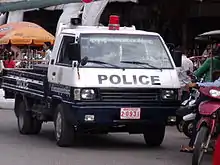Crime in Cambodia

Crime is present in various forms in Cambodia.
Crime by type
Murder
In 2017, Cambodia had a homicide rate of 2.4 per 100,000 population.[1]
Robbery
Petty crime is common, with tourist areas often targeted. This includes snatch theft and pick-pocketing. Perpetrators are usually stricken with poverty, and as a result are driven to steal from foreigners with the knowledge that they bring about a significant amount of money and other valuable items. Owing to the easy accessibility of arms, armed robbery also occurs.[2]
Corruption
The rate of corruption in Cambodia is high; one source goes on to describe the situation as "nothing less than obscene". Corruption is considered a large expense to the Cambodian government.[3] The Cambodian police force is known to inappropriately use violence in certain cases.[4] The misuse of ferocity has raised concerns from the Human Rights Watch.[5]
Prostitution
Prostitution is against the law in Cambodia, but still present and only growing. Le Thi Quy, a professor from the Women's Research Center, interviewed a handful of females in 1993 about prostitution; three quarters of the interviewees found being a prostitute to be a norm and a profession they felt was not shameful having.[6] That same year, the professor estimated that there were some one hundred thousand sex workers in the country.[6]
Sex trafficking
Cambodian citizens, primarily women and girls, have been sex trafficked within the country and throughout the world.[7] They are threatened and forced into prostitution, marriages, and or pregnancies.[8]
Illegal logging
See also
References
- Global Study on Homicide. United Nations Office on Drugs and Crime, 2013.
- "Cambodia". travel.state.gov. Archived from the original on June 20, 2013. Retrieved June 13, 2013.
- Curtis, Grant (1998). Cambodia Reborn?: The Transition to Democracy and Development. Brookings Institution Press. pp. 147–. ISBN 9780815791379.
- "Protest Claims Police Brutality in Cambodian Home". 95.5 WBRU. January 14, 2013. Archived from the original on December 12, 2013.
- "Cambodia: Escalating Violence, Misuse of Courts". Human Rights Watch. February 1, 2013.
- Barry, Kathleen (1996). The Prostitution of Sexuality. NYU Press. pp. 137–. ISBN 9780814712771.
- "Cambodia UN ACT". UN ACT.
- "Inside the world of Cambodia's child sex trade, as told through the eyes of a survivor". ABC News. March 8, 2017.
- Ikunaga, Meguri. The Forest Issue in Cambodia : Current Situation and Problems : An Analysis Based on Field Research. Occasional Paper. Tokyo: Foundation for Advanced Studies on International Development, International Development Research Institute, 1999. Print.
- Hansen, Kasper K., and Neth Top. Natural Forest Benefits and Economic Analysis of Natural Forest Conversion in Cambodia. Working paper no. 33. Phnom Penh: Cambodia Development Resource Institute, 2006. Print.